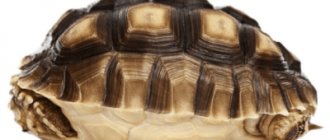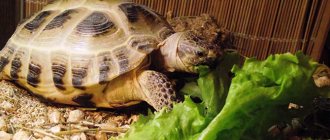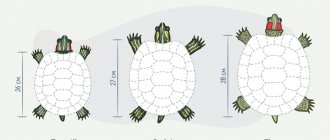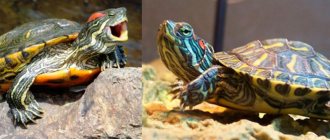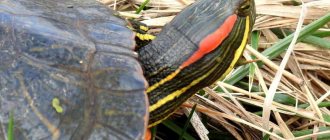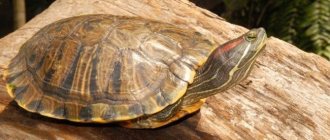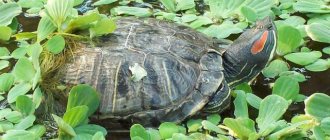There are a huge number of different species of turtles around the globe. These reptiles are divided into two categories: terrestrial (living on land) and aquatic (living in water). Only aquatic turtles are kept for home keeping, because... Due to the decrease in their numbers, land turtles are included in the Red Book.
Of course, from photos on the Internet it is difficult to distinguish aquatic turtles from land ones, but their main distinguishing feature is the presence of swimming trunks, thanks to which they swim freely in the water.
Description and features
The name of the red-eared turtle clearly reflects its main feature - red stripes on the sides of the head in the area of the ears. In German they are called red-cheeked, and red-headed ones are sometimes included in searches. This species belongs to the family of American freshwater turtles.
She usually swims leisurely in search of food. Having eaten, it crawls ashore to bask in the sun. It lives from tropical to equatorial zones, so when the water temperature drops to 18 °C it becomes passive and lethargic.
Where does it live?
The red-eared slider's historical range includes a wide area from the southern United States to northern Colombia and Venezuela. Reptiles prefer shallow lakes, small ponds without steep banks. Turtles lead a sedentary lifestyle: they either leisurely look for their next prey, swimming in a pond, or, having had their fill, crawl ashore and bask in the sun. If danger is detected, turtles suddenly take off and dive into the water.
The high endurance of red-eared turtles led to the fact that they were artificially introduced to the countries of Europe, Southeast Asia, Japan, China, and South Africa. In Australia, reptiles are officially recognized as pests, since they successfully compete with the local endemic reptofauna and displace them from their usual habitats. Unfortunately, red-eared turtles can increasingly be found in urban ponds in our country; most of them were released by their owners.
Habitat
In nature, the turtle lives in Central, southern North and northern South America. These waterfowl turtles love bodies of water with sun-warmed, near-stagnant water and gently sloping banks.
Due to their extreme prevalence as pets, bodies of water with suitable climates have been colonized throughout the planet. They adapt well to anything from slightly salty water to life in city canals. They also learned to winter in cold conditions - they were repeatedly observed even in the Moscow region.
IMPORTANT: To date, the number of red-eared turtles introduced into the ecosystem of many countries has increased so much that it threatens its balance. They quite actively eat local plants, fry, fish and frog eggs and insect larvae. This has already become so widespread that in many regions the import of these animals is prohibited by law. In the photo, blue indicates the original habitat of the red-eared turtle, red indicates the current habitat.
Care and maintenance
People love to have animals at home. And it is not always truly domesticated. Turtles are wild animals that are unlikely to respond to their owner with warm feelings of mutual love. Nevertheless, they are quite often chosen as a pet. Taming an animal is a big responsibility, and one must take it upon oneself consciously. The turtle needs to be provided with all the necessary conditions and quality care.
The aquatic turtle is much more whimsical than the land turtle. Arranging her terrarium is more complicated and requires large investments. The volume of the aquaterrarium must be at least 100 liters, and a third of it will be on the land island. The reptile can climb out onto it to bask under a UV lamp. An ordinary 40 or 60 W incandescent lamp is also placed above the turtle’s home for lighting. The rest of the terrarium is filled with water, which is constantly heated using a special heater.
When purchasing an aquarium-terrarium for your pet, you should take into account that any turtle will grow and increase in size over time. Therefore, you should not save money and buy a small “house”; it is better to choose one with a reserve of volume.
Natural enemies
Thanks to its thick shell and relatively large size, the red-eared turtle faces few threats, with the exception of alligators and crocodiles. Plus, they quickly slide into the water at the slightest sign of a threat from the shore.
But there are a lot of predators hunting for young turtles:
- foxes,
- skunks,
- raccoons,
- various wading birds.
Mammals on this list also dig up their eggs. In general, in their natural habitats, red-eared turtles are an important element of the food chain, both as prey and as a predator. And in urban reservoirs they become a source of food mainly for stray dogs and cats.
Young turtles have an interesting type of defense against being eaten by fish. If a fish swallows them, they begin to chew the mucous membrane from the inside until the fish spits them out. The turtles are brightly colored, and the fish quickly remember that they cannot be eaten.
Population and species status
Photo: What a sea turtle looks like
Sea turtle population numbers are extremely difficult to track due to the fact that turtle populations are so scattered and turtles migrate long distances. However, it is known that due to human activities, the population of sea turtles has greatly decreased. First of all, the decline in the population of sea turtles is caused by the ruthless hunting of these creatures in order to obtain meat and valuable shells.
The arrival of civilization and the development of beaches in turtle breeding areas also had a negative impact on the population of sea turtles. Many turtles are afraid of noise, electric lighting and large numbers of people on the beach and simply do not come ashore to form clutches. Many turtles die after being caught in fishing nets and swallowing debris floating in the water.
At the moment, most species of sea turtles are listed in the Red Book as endangered species and particularly vulnerable species. Hawksbill turtles are almost completely extinct, so hunting them is prohibited throughout the world. However, there are black markets where poachers sell turtle eggs and turtles of this species and the demand for them continues unabated. All over the world, measures are being taken to protect rare species of turtles to restore the populations of these animals.
Appearance
The maximum size of a turtle's shell sometimes reaches 40 cm, the average size of adults is from 15 to 30 cm. Females are significantly larger than males. The carapace consists of two parts: the upper one - the carapace and the lower one - the plastron.
At a young age, the color of the shell is rich green. Then it darkens and becomes brown or brown. As one ages, an intricate pattern appears on it. The color of the plastron does not change - it is light yellow with darker spots in the center of each plate. All exposed skin of the animals is dark green with thin longitudinal, slightly sinuous yellow lines. irregular shape.
The stripes on the head, which give the turtle its name, can be either red or orange or yellow, depending on the subspecies. The turtle does not have real external ears or even auditory canals; they hear only through the middle ear.
INTERESTING: The shell of a red-eared turtle is not only bone tissue, it contains nerve endings. The turtle feels touches not only as vibrations, but also directly. If she doesn't like it, she starts hissing.
Popular types
These turtles have three subspecies:
- red-eared or Florida,
- Cumberland or Trust's tortoise,
- yellow-bellied slider.
Red-eared or Florida (trachemys scripta elegans)
The shell of the Florida red-eared slider reaches 280 mm. The photo clearly shows its wide postorbital stripes and narrow stripes on the chin - red, which gave the name to the whole species. Each carapace plate has a transverse yellow stripe, and the plastron plate has a large dark spot. The subspecies is found mainly in the western and central regions of its natural habitat.
Cumberland or Troost's turtle (trachemys scripta troostii)
Trust's turtle is the smallest subspecies. It does not exceed 21 cm in length. The narrow postorbital stripes and the wide stripe on the chin are yellow. Each of the carapace plates has a yellow transverse stripe. The plastron scutes are decorated with “eyes” or small dark spots. This subformation has the smallest area of occupation, which is located in the upper Cumberland and Tennessee.
Yellow-bellied slider (trachemys scripta scripta)
The length of the carapace of the yellow-bellied slider reaches 27 cm. Its postorbital spots are yellow and connect to a stripe on the neck. There is also a yellow stripe on each carapace scute. There are dark spots on the anterior scutes of the plastron. This subspecies inhabits mainly the eastern part of its natural habitat.
Such different reptiles
In nature, there are many varieties of these reptiles. The most famous species of sea turtles are:
- The leatherback turtle is the largest sea turtle. The span of the front flippers of a leatherback turtle reaches three meters; the size of the shell is approximately the same. Weight can reach 900 kg. The leatherback turtle received this name because of the surface of the carapace, which is covered with dense skin. The giant sea turtle is considered the oldest. American authorities have created a national park on the habitat of leatherback turtles;
- Green sea turtle (or soup turtle). The length of her body reaches 1.5 meters. The weight is much less than that of the leatherback turtle and does not exceed 250 kg. The dimensions of the shell range from 80 to 120 cm. The color is different - it can be either light green or dark brown, but always with white spots and stripes. The carapace is oval, small in height, covered with large horny scutes. Delicacies are prepared from the meat of this turtle;
- Hawksbill turtle - similar to a green reptile, but slightly smaller - body length about 80 cm. Weight - 40-50 kg. The carapace is heart-shaped, brown with yellow spots, covered with thick horny scutes. Its posterior part is narrowed and sharpened. A distinctive feature is a strong horny beak.
How to choose?
Young red-eared turtles with a shell length of no more than 5-6 cm are usually found on sale. They do not need a large aquarium, but it is worth considering that in a few years they can grow up to 20-30 cm, and you will have to change their tank.
It is necessary to carefully evaluate the appearance of the future pet. Lethargic behavior, and especially lying with your eyes closed, are not good signs. Then you should inspect the shell. It should be firm and free of defects. All claws must be present on the paws; no foreign formations are allowed on the head. If the turtle is in the water, it should swim vigorously, maintaining an even body position.
Keeping red-eared turtles at home
Keeping these pets is not too difficult, but it has certain features. It is worth learning about them before purchasing a turtle.
Selection and arrangement of a terrarium
The red-eared turtle needs a spacious “house”. The volume of the aquaterrarium must be at least 100 liters. In proportion, the width should be significantly greater than the height, but at the same time from the highest point on land to the top edge of the aquarium you need at least 30 cm. Otherwise, the turtle may jump out of the aquarium, get hurt, or crawl into some secluded corner in the apartment. Other pets can also harm her. The photo shows the approximate layout of an aquarium for a red-eared slider.
Decorative elements
Turtles lead a half aquatic and half land lifestyle. Therefore, a prerequisite for an aquaterrarium should be the installation of an island of land, the size of which should be a quarter of the bottom area. Turtles bask and rest on it.
These islands are ready-made and can be purchased at a pet store. When choosing, you need to pay attention to the following qualities:
- harmlessness - when heated by a lamp, it should not release toxins;
- the slope is gentle on at least one side - so that it is easy for the turtle to climb out;
- stability - so that the turtle does not turn it over;
- textured surface - so that the animal does not slide on it;
- absence of sharp edges and burrs - so that there is no risk of injury;
- safety of the installation - so that the pet does not get stuck between it and the wall of the aquarium;
You can make an island with your own hands, because in nature, turtles crawl out of the water onto snags, stones and generally any rubbish sticking out of the water.
Equipment
Two lamps must be installed above the island where the turtle will rest. One is for heating. It is better to use special lamps for reptiles, for example, the Repti Zoo Friendl infrared lamp. It allows you to automatically maintain the desired air temperature. But you can choose the power of an ordinary incandescent lamp plus a thermometer. The air temperature on the island should be between 30-32°C.
The second lamp is ultraviolet. In apartment conditions, turtles do not receive ultraviolet radiation, and without it they do not produce vitamin D, which is involved in the absorption of calcium. Living in its absence leads to rickets in turtles. It is necessary to use devices with a power of 5-10% UVB, for example the Exo Terra Repti Glo 5.0 Compact lamp.
There are now heat lamp and UV lamp kits on sale, such as the Lucky Reptile lighting kit. Both lamps should be placed out of reach of the turtle to prevent it from getting burned or accidentally breaking them. To avoid eye burns, the lamps are hung at least 20-25 cm from the surface of the island. Lamps must be turned off at night. German herpetologists give the following recommendations on water temperature and duration of illumination for red-eared turtles by month:
| Name of the months | For the Florida turtle | For the turtle Trust | ||
| Temperature °C | Duration of illumination, hours | Temperature °C | Duration of illumination, hours | |
| January | 18 | 8 | 18 | 8 |
| February | 18 | 8 | 18 | 8 |
| March | 18 | 8 | 18 | 8 |
| April | 21 | 8 | 20 | 8 |
| May | 24 | 10 | 21 | 10 |
| June | 27 | 13 | 23 | 13 |
| July | 28 | 13 | 26 | 13 |
| August | 28 | 11 | 25 | 11 |
| September | 25 | 10 | 20 | 10 |
| October | 22 | 8 | 18 | 8 |
| November | 18 | 8 | 18 | 8 |
| December | 18 | 8 | 18 | 8 |
The vital activity of turtles quickly pollutes the terrarium, and it is necessary to keep the water clean. To do this, you need to organize filtering. You can use both external and internal filters, or sets of both for more effective cleaning. As an external filter, we can recommend Lucky Reptile Thermo Clean 150, and as an internal filter, Tetra DecoFilter 300 for reptiles, which has a decorative design in the shape of a rock.
Water
Clean water is very important for the health and full development of turtles. The aquaterrarium must be filled with water that has been left standing for five days.
The minimum water level depends on the body size of the turtle - when standing up to set its paws, it should only stick its head out of the water. The water temperature should be maintained at 25-28°C. Usually, warming up the air in the terrarium with a lamp is enough. Hardness and acidity are not significant for the turtle.
Plants and soil
Turtles themselves do not need plants or soil. But to improve the appearance of the terrarium, you can use stones, but only large ones. To prevent the turtle from accidentally eating them, their size should be larger than its head. In addition, the fine fraction of soil complicates cleaning the aquarium.
The aquaterrarium can also be decorated with artificial plants. Live turtles will simply be eaten quickly. Even for artificial ones, it is necessary to select harder and thicker specimens.
INTERESTING: Turtles of this species can change the color of their shell and skin depending on the surrounding soil. For example, when transferred to new scenery, they may noticeably lighten and turn yellow. But this does not happen instantly, like a chameleon, but in a couple of hours.
Compatibility
Turtles and aquarium fish live together, but this is an exception to the rule. Yes, while red-eared turtles are small, they cannot yet swallow neighbors of comparable size to them. Therefore, they can be kept in an aquarium with some predatory fish, such as cichlids. But, firstly, they need quite specific conditions for heating, irradiation and the presence of an island. Secondly, they grow very quickly and are active predators. If they don’t immediately eat the fish, they will constantly swim with their fins bitten off. For the same reason, it is not recommended to combine red-eared turtles in the same aquarium with amphibians - axolotls, newts, frogs - they also will not last long.
So the best option for keeping red whales is a species-specific aquaterrarium. But several turtles can only be kept together if they have enough space both now and in the near future. And even in this case, keeping turtles of different sizes in the same area is not recommended. This is dangerous, as is the case with aquarium fish. The predatory instincts of turtles extend even to members of their own species.
What is the price?
Prices for a red-eared turtle range from 100 to 2500 rubles.
If you are a beginner, you may not be able to cope with several turtles at first, so you should first buy one pet, and after a while another one.
During the warm season, the purchased animal can be carried home in a plastic container or box with sawdust. If it's cold outside, it is recommended to put a heating pad in the box. You can also wrap your pet in a cloth and hide it under a jacket.
How to care for a red-eared slider
Caring for an aquaterrarium with turtles involves changing a fifth of the water weekly while simultaneously cleaning the soil surface using a siphon. Since it is not always convenient to leave water for 5 days, you can use Tetra ReptoSafe conditioner, which removes chlorine from water and also enriches it with vitamins.
You can also add Tetra ReptoFresh conditioner with each water change. It helps waste decompose faster, making water cleaner and reducing unpleasant odors from rotting organic matter.
The PRODIBIO Aqua'Turtle set was developed especially for keeping aquatic turtles. It combines the biological preparation Aqua'Turtle Bacter, consisting of bacterial strains, and Aqua'Turtle Odor, which eliminates unpleasant odors. The manufacturer recommends using the product after each water change and in case of an unpleasant odor.
The red-eared turtle itself requires claw care. When living in an aquarium, they do not wear down, as in natural conditions, so they must be periodically shortened with pliers, being careful.
In warm weather, it is advisable to take turtles outdoors, avoiding direct sunlight. The duration of such “sunbathing” should be increased gradually, starting with 5 minutes a day.
If you take good care of your turtle - this will ensure that it is active and healthy for many years - red-eared turtles can live in captivity for up to 40, and sometimes 50 years.
What to feed red-eared turtles at home
A balanced diet is important for turtles. First of all, of course, they need protein food, since they are predators. Adult red-eared turtles can be given cockroaches, earthworms, and thinly sliced meat. Small red-eared turtles - bloodworms and river crustaceans. Once every one to two weeks you can give beef liver.
You can give your turtle a “fish day” a couple of times a week. You must take river fish - freshwater turtles do not have the opportunity to eat sea fish in nature. It must be doused with boiling water and cut into strips. Small bones should not be removed - turtles do an excellent job with them, plus they are an additional source of calcium.
But you can’t feed your turtle only meat and fish. Greens are also important, otherwise the likelihood of developing rickets increases. This is especially important for adult individuals - they are more herbivorous. If for young people vegetarian food in the diet should be 2/3, then for adults it should be about 50%. Turtles can be given chopped seaweed, pieces of lettuce and cabbage. In the summer, you can collect fresh dandelion and plantain leaves and aquatic plants (duckweed, hornwort, etc.) for your pet.
You can use the special balanced food Tetra ReptoMin. It contains not only proteins, fats and carbohydrates in optimal proportions, but also calcium and phosphorus. The food comes in the form of dry sticks floating on the surface of the water. It is turtle-friendly and residue can be easily removed, keeping the water clean. It also contains yucca extract, which reduces unpleasant odors from turtle excrement. The food is available in different sizes:
- Baby - for kids,
- Junior – for medium-sized turtles,
- Sticks – for adults.
Turtles up to a year old need to be fed once a day, after a year - once every 2-3 days.
IMPORTANT: These aquatic turtles do not produce saliva, so they must have their head completely submerged in the water to swallow food. Feed them only in water.
There should be calcium in the feeding area, right in the water. It is necessary for the bones and shell of the animal. You can use special calcium blocks or mineral supplements, such as Tetra ReptoCal.
Sometimes you can pamper your turtles with special treats:
- Tetra ReptoDelica Snack – fortified snacks from daphnia;
- ReptoDelica Grasshoppers – dried grasshoppers;
- Tetra Gammarus is a dried freshwater gammarus crustacean.
Pets also need additional feeding with vitamins. For example, you can use Tetra ReptoSol concentrate. It is liquid and can easily be dripped onto the food. Can be used once a week.
Hibernation
The natural habitat of the red-eared turtle is from the equatorial to the tropical zone. Living conditions at a temperature of about +35 degrees Celsius do not force it to hibernate. But at the same time, the widespread artificial distribution of these turtles in many countries has changed their biorhythms. In October, when the air temperature drops below 10 °C, they become inactive, sink to the bottom of reservoirs and overwinter there. They do not eat or defecate, their breathing rate drops, and their heart rate decreases. Therefore, the question of whether pet turtles need to hibernate is controversial among scientists. But not every owner is able to correctly prepare a pet for hibernation, provide him with suitable conditions throughout its entire duration, and then competently bring him out of this state.
Therefore, red-eared turtles living at home hibernate quite rarely. But if this does happen, you must adhere to the following recommendations:
- Reduce water level. The turtle burrows into the ground, where it sleeps without rising to the surface, receiving air using special membranes in the mouth and cloaca.
- Turn off backlighting and filtering. The movement of water contributes to the destruction of the thermal layer around the animal.
- Naturally, do not try to feed the turtle or touch it at all.
- Monitor her well-being. If she doesn’t wake up in February, she needs to be woken up.
Breeding and reproduction
Breeding these animals at home is quite labor-intensive. Requires certain knowledge, some experience and the presence of an incubator.
Sexual differences between male and female
First of all, it is necessary to determine the sex of the animal. But turtles take a long time to mature and look almost the same in childhood. So it is possible to reliably identify their gender only after 7 years. There are several ways to do this:
- Abdominal shield or plastron. The shell of females is smooth underneath. In males it is modified - closer to the tail there is a notch on it. During mating, it adjoins the convex upper part of the female’s shell, facilitating a better fit of the genital organs to each other.
- Fingers and claws. Males have elongated fingers, and the claws are elongated and slightly curved.
Females have short fingers and almost no claws at all.
- Tail. The shape of the tail in males approaches triangular. Females have a straight and shorter tail.
- Muzzle. In males it is slightly pointed, and in females it is somewhat flattened. But this is only an additional sign.
- Activity. Males are more energetic. They constantly run or swim around their aquaterrarium, taste everything, and shake their heads. Females are calmer.
Conditions for reproduction
Physiological readiness for mating is determined by the length of the shell. Eleven centimeters are enough for a male, seventeen for a female.
An incentive for reproduction can be maintaining a temperature of at least 26°C, together with a gradual lengthening of daylight hours and lighting intensity. Turtles, especially females, spend significant resources on reproduction. Therefore, during mating and gestation, they need nutrition, including phosphorus, calcium and some vitamins.
To form pairs, several turtles are kept together. It is desirable that the proportion of males and females be maintained at one to two, otherwise there will be too much competition between males. Males ready to mate engage in fights, attracting the attention of females. If a pair has formed, it should be placed in a separate aquarium.
It requires a container with soil with a layer of at least 5 cm in which the turtle will lay eggs. Sand or peat is suitable as a filler. A lift must be attached to the container to allow the turtle to climb inside.
How do red-eared turtles reproduce?
The readiness to mate directly is indicated by the behavior of turtles. Males begin to tap on the shells of their partners and tickle their cheeks with their claws. The entire courtship lasts about 45 minutes. Females show their readiness by approaching the male and diving to the bottom.
Mating occurs in water no deeper than 12 centimeters and takes 10 minutes. This will allow the baby turtle to breathe during the process.
One mating is enough for 4-5 clutches of eggs with intervals between them of 2-5 weeks. At the same time, the female lays from 2 to 30 eggs. Towards the end of pregnancy, the female begins to look for a suitable place to lay eggs. It is very important because if it is missing, she will lay eggs in the water or continue to carry them further, which will lead to their hardening. This can cause infection and death of the animal.
The female digs a hole-nest in the ground using her hind legs. If the turtle has laid one or two eggs, then the clutch is most likely not finished, and you need to help her dig a hole.
Turtles do not care about their offspring in any way and abandon the clutch.
Egg development takes from 59 to 112 days. They need to be transferred to an incubator. They are homemade and industrial.
A homemade incubator for red-eared turtles is made according to the approximate diagram in the photo:
It is based on a closed glass or plastic container in which a cuvette with substrate and eggs is placed. There should also be a vessel with water for humidification, a heater to maintain temperature and a thermometer.
But you can also find industrial incubators for reptile eggs, such as the Zoo Med Reptibator Egg Incubator. It is equipped with a liquid crystal display and electronic temperature and humidity sensors. The temperature can be set in the range from 15 to 40°C, and humidity – from 10 to 95%. The transparent lid allows you to observe the eggs without opening the incubator.
The baby turtle remains inside the shell for two days after hatching. There they feed from the yolk sac, part of which still remains in the egg. But babies will be able to swim only after 21 days, when the place through which the yolk was absorbed has healed. Newborn turtles are kept separately from adults, as they can damage them.
Interesting: The sex of developing turtles depends on the soil temperature. If the sand heats up to 30 degrees or more, females are produced, and at temperatures up to 27 degrees, males are produced. So this issue can be regulated independently.
Should you pick up a turtle?
Let us remind you that red-eared turtles live at home in an aquarium . When removing an animal from the water, be prepared for it to be slippery. But this is not the main difficulty. The yellow-bellied creature is 100% likely to resist such contact. The turtle will begin to hiss, scratch you with powerful paws with sharp claws, bite, and it is possible that he will attempt to empty his bowels directly into your palm.
So in theory, you can pick up your pet, but is there a need for this tactile contact? If touching cannot be avoided, take the animal with both hands, fix it carefully but firmly, then the turtle will not slip out and you will not be bitten.
After contact, be sure to wash your hands with soap. Make sure that children do this especially. Explain to kids that affection with red-eared cats is unacceptable: these creatures, cute at first glance, can be dangerous, because carry salmonellosis. For this reason, animals should not wander around the kitchen and, especially, the dining table. You should also avoid washing your pet or its aquarium and accessories in the kitchen sink or bathtub.
Diseases - prevention and treatment
Almost 90% of cases of diseases of red-eared turtles occur due to improper care, housing conditions and feeding, or all at once. If an animal is sick, do not treat it yourself, go to a specialist. A lot of situations require veterinary diagnosis.
Types of diseases
Pneumonia. The turtle becomes lethargic and cannot dive, although he tries. There may be discharge from the mouth or nose, and wheezing is common. As in humans, pneumonia can be unilateral or bilateral. The latter most often leads to death. The disease is most often caused by temperature changes - red-eared turtles are extremely thermophilic. Treatment may include inhalation with chamomile decoction. The pet must be periodically held over the container with it so that it inhales the medicinal vapors. The temperature of the steam must first be checked with your hand so that the turtle does not get burned. It is also important to remove sources of cold - otherwise treatment will be useless.
Rickets. This is a calcium deficiency caused by a lack of ultraviolet radiation and poor diet. For example, a purely meat diet leads to it. Red-eared turtles need both protein and fiber and carbohydrates. When sick, the reptile's skull and other bones do not soften, only the shell suffers. It softens and may become warped. Problems with feeding the red-eared slider may also arise. In the most advanced cases, the animal may die. Treatment consists of injections of calcium supplements, changes in diet and increased UV radiation.
Skin diseases. They are caused by an unbalanced diet, for example, a lack of vitamins A and B. The skin begins to peel off. It is necessary to strengthen your diet with foods high in these vitamins. But in order not to overdo it and cause hypervitaminosis, it is better to use special supplements - the vitamin content in them is strictly dosed. Additionally, you can take care of your skin using products prescribed by specialists.
Sepsis or blood poisoning. It mainly occurs as a result of injury to the skin, through which bacteria enter the blood directly from dirty water. Symptoms of sepsis may include weakness, passivity, and redness of the paws or shell. Treatment must be urgent and is carried out with antibiotics prescribed by a veterinarian.
Abscess in the ear. The most common cause in turtles is dirty water. The disease manifests itself as inflammation or swelling on the head. Since turtles do not have ear canals, treatment is carried out only by surgery under general anesthesia.
Conjunctivitis. The turtle's eyes become swollen or red and he cannot open them. There may be various discharges from the eyes. Turtles are prone to eye infections. The disease is contagious, and the sick turtle must be separated from the others. In order not to aggravate the disease, it can only be put into water for 1-2 hours a day. Treatment consists of antibiotic drops in the eyes. Ordinary human ones are suitable, for example Diclofenac. You also need to replace the water, clean the terrarium, and check the temperature. If you start therapy at the first symptoms, a couple of days of treatment will be enough.
Bacterial infection in the mouth. Symptoms will be formations in the mouth, usually necrotic in nature. The animal stops eating and may not open its eyes. This is a very serious condition that requires immediate treatment. The oral cavity should be periodically cleaned with a gauze swab with an antibiotic solution, removing the affected tissue. With timely treatment, it can be cured well.
Bacterial skin infection. Usually caused by bacteria that have entered the skin due to injury - a burn from a lamp, injury from sharp objects, or other illness. Symptoms will be a soft shell with visible hemorrhages. The affected area rapidly increases in size. There may be an unpleasant odor from the turtle. It is necessary to remove dead tissue and treat the affected area with antibiotics prescribed by a veterinarian until complete healing.
IMPORTANT: Red-eared sliders are recognized as carriers of salmonella bacteria. If these animals are handled incorrectly, people can become infected. This led to legal restrictions on their sales in a number of countries.
Diseases
Keeping a pet is not only a joy, but also possible problems. They may be associated, among other things, with the health of the animal, because they get sick just like people. Turtle diseases can affect different organs. Therefore, it is important to pay attention to the appearance and behavior of the turtle. At the first signs of deviations, treatment measures must be taken immediately.
Most often, aquatic turtles experience various types of inflammation. In particular, otitis (inflammation of the inner ear), abscesses (areas of inflammation on the extremities), conjunctivitis (inflammation of the eyelids), pneumonia (pneumonia). The latter is accompanied by symptoms such as falling on one side, constantly sitting on land, wheezing, mouth breathing, and pallor of the mucous membranes. In this case, immediate contact with a specialist is required.
Aquatic turtles often suffer from dermatitis caused by fungi and bacterial infections. They affect both the skin (pimples, redness, ulcers) and the shell (crumbling, peeling of scutes).
With improper nutrition, turtles develop deficiencies of various vitamins and minerals (D3, A, calcium, iron and others). Reptiles are not protected from injuries: bruises, burns, wounds, scratches.
The most important thing for any illness and injury is timely treatment and prevention.
